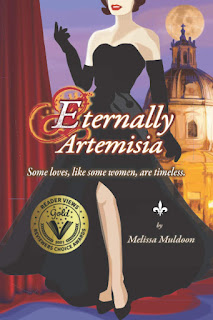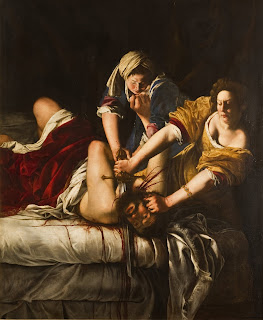Weekly Reader: Eternally Artemisia by Melissa Muldoon; Beautiful Historical Fantasy About The Timeless Links Between Art, Romantic Love, and Female Friendship
By Julie Sara Porter
Bookworm Reviews
Spoilers: I have it. I figured out the solution.
Last year's literary themes were biker gangs, motorcycle clubs, and travels by motorcycle, multicultural teen superheroes, post apocalyptic dystopian science fiction and fact, and trips through Heaven and Hell with plenty of religious allegory. It makes sense, except for the travel by motorcycle bit, every one of these subjects in one way or another wanted to face the real life traumatic situations head on. 2020 was a dark year and we were looking for solutions even in fiction.
This year the themes seem to want to get away from the darkness as much as possible. With Regency Romance and Epic Fantasy (not yet but five yes five Epic Fantasy reviews are on their way) there is an overwhelming urge to escape the darkness that surrounds us. This is also evident in one of the biggest themes that I have encountered this year: science fiction and fantasy featuring time travel and reincarnation starring friends and lovers who encounter each other who meet from different times or travel across oceans of time to find one another once more.
These types of books offer the strongest escapism. After all, what better way to escape than to a seemingly simpler time or even better various times? (Never mind that those periods had similar problems or worse, as well but whatever, we are reading here!)
I have read Canvas of Time by Amelie Pimont, Rosemary for Remembrance by Nikki Broadwell, and Trapped in Time by Denise Daye all with similar themes. Now we can add Melissa Muldoon's Eternally Artemisia to that list. This book is one part fantasy about a woman discovering that she has shared a long link with Renaissance painter Artemisia Gentileschi, but also one part historical fiction about Gentileschi's life and the legacy that her art has inspired through the years.
For those that don't know, Artemisia Gentileschi was a portrait painter in Renaissance Italy. She was an exception to the rule of many talented but unsung women of her day in that she was taught to paint by her father, Orazio. She was also tutored by Agostinio Tassi. One day, Tassi raped her. Gentileschi was put through a very public and humiliating trial in which her body was observed. Tassi was found guilty and exiled but the damage was done as Gentileschi was seen as a fallen woman and damaged goods. She was also estranged from her father who cared more that Tassi had stolen a painting than the violence inflicted upon his daughter.
She was then practically sold into marriage to Pierantonio Stiattesi, a fresco painter, for money. The two made their way to Florence where Gentileschi became the only female to be accepted to the Arts Academy in Florence. Even though she gave birth to a daughter, Palmira and two other children, her marriage to Pierantonio ended in a separation because of his jealousy of her talent and his infidelity.
Gentileschi was a student of Caravaggio in that her paintings often revealed shadows, dark colors, and violent scenes. Her two most well known portraits are based on stories of the Bible and many believe reflected her rage about the rape and the trial. The first, Susannah and the Elders, shows a young woman walking and being the subject of gossip by older men.
Her most famous painting is Judith Beheading Holofernes. This painting depicts Judith and her handmaid, Abra, holding the king down right as the Biblical heroine goes in for the kill. The blood around Holofernes' horrified visage and the looks of determination on the two women's faces speaks volumes.
For a straight historical fiction on Gentileschi's amazing life look no further than The Passion of Artemisia by Susan Vreeland which tells of her life from beginning, middle, and end. (It can be found as #7 in this Historical Fiction Novel list.) For a tale that is more wide reaching that is more than about Gentileschi herself, but is also about her legacy and how those who are drawn to her story are drawn to each other, then Muldoon's is the book for you.
I am saying this because while Gentileschi is frequently discussed, her actual life experiences only cover a third of Eternally Artemisia. Instead it is her art and spirit that are shown through various lifetimes from the Bible, to the Renaissance, to the 1930's, to modern day, to the distant future.
The book begins with an introduction from Biblical days when Judith and Abra are standing over the drunk and sleeping Holofernes. They both are ready to commit violence in vengeance over the death of Judith's husband and many Israelites. The bond between Judith and Abra is clearly felt beyond mistress and servant as the two are forever united in this bloody moment which will be immortalized in art.
The moment between Judith and Abra is emphasized and recalled in the present with the experiences of Maddelena AKA Maddie, an art therapist. Maddie travels to Italy to get in touch with her roots and get some artistic inspiration. She flourishes in the Tuscan landscape by creating a circle of creative women that inspire and encourage one another and becomes romantically involved with Matteo, one of a very old established Italian family. Maddie falls in love not only with Matteo but the whole Florentine landscape like she knew him or had been there before.
She also has a fascinating "woman-crush" on Gentileschi and begins to see Gentileschi's life through her eyes. She also gets visited by Gentileschi's spirit who advises her to take a real close look at the portrait of Judith Beheading Holofernes, and tell her what she sees. Maddie sees that Judith has Gentileschi's face and that Abra has her own. Yes, Gentileschi replies, she and Maddie have been friends practically sisters for centuries. Not only that but Maddie has shared multiple lives with Matteo. The rest of the book focuses on those other lives.
Like I said, since the book travels through time, Gentileschi's actual personal life is given a surprising short shrift. Only her time in Florence, her unhappy marriage, and the patronage of the Medicis towards her art are discussed. She also makes some equally talented friends in Michelangelo Buonarroti the Younger and Galileo Galilei.
It is through these talented friends that Gentileschi encounters this version of Maddie and Matteo. In the Renaissance, Matteo is an astronomer fascinated by the studies of Galileo and Copernicus.
Maddie is a courtesan who is looking to soak up the local arts and cultural scenes. She even models for various paintings including (of course) Judith Beheading Holofernes.
The chapters are some of the best parts in the book because of the intricate plot and characters that are woven throughout. For those hoping that Tassi should get some retribution, it comes swift and clever. Gentileschi and Maddie give Gentileschi's rapist vengeance that hits him right where he deserves...right in the reputation.
Muldoon also gives much attention to how Maddie, Matteo, and Gentileschi flourish in their Renaissance environment. These are three people who are excited for the opportunities that the Renaissance provides for artists and scientists, particularly under the protectorate of Cosimo de Medici. Medici encourages great ideas even if, like Galileo's, they counter the church. They are allowed to flourish, educate, and encourage others. Unfortunately, that protection only lasts as long as Cosimo does. After he dies, the Archduchess and her priests go on a cleansing to get rid of ideas that they find offensive so the artists, scientists, and thinkers scatter. The Power Trio of Gentileschi, Matteo, and Maddie are separated only to reunite next time.
The second best section is in the 1930's which intersects the fictional incarnations of Maddie and Gentileschi with a real life pair. According to Muldoon's notes at the end, the 20th century version of Maddie is based on Elsa Schiaparelli, a fashion designer who was known for her eccentric styles such as elaborate embellishments on clothing and unusual accessories like shoe shaped hats. She was also known for her antifascist stance which she openly spoke against Hitler and Mussolini (in contrast to her frequent rival, Coco Chanel who cozied up to the Nazis. Their rivalry is played out in the juicy historical fiction, The Last Collection by Jeanne Mackin.).
Gentileschi's counterpart, called Luciana, is based on Anna Banti who was the first to gather information on Gentileschi and write about her. Through Banti, we now know Gentileschi's name. Without her preservation of her art and research into her life, Gentileschi might have been one of those women hidden by history that Virginia Woolf spoke about. It is wonderful that Muldoon paid tribute not only to the artist, but the woman who gave her a second posthumous life. Like all researchers, Luciana protects her research with her life. When Mussolini comes in, she makes sure when she leaves that her research either comes with or is expertly hidden.
As the Schiaparelli stand-in, Maddie also shines as does her husband, the latest Matteo. One of the more interesting moments when she is told that someone is interested in her pantsuit and is looking to revitalize her look for her Hollywood image. Into her shop strolls Katharine Hepburn. This moment links the arts of painting, fashion, and cinema in one continuous cycle. Maddie is naturally incensed when the strict fascist rule deprives women of many of their rights including running their own business. The more Maddie and Matteo remain in Italy the more dangerous their life becomes, particularly when they are at a party that is also attended by Mussolini and Maddie literally finds herself dancing with the devil.
There is a brief epilogue where Maddie, called Lena, is in the future and arrives at a space station named Artemisia (of course) and meets another astronaut named Matt (also of course.) Like many books that explore reincarnation, bodies may die but souls remain and the things that capture our souls: art, history, literature, science, memories, families, friendships, and all of those things are what are preserved and continue.


No comments:
Post a Comment